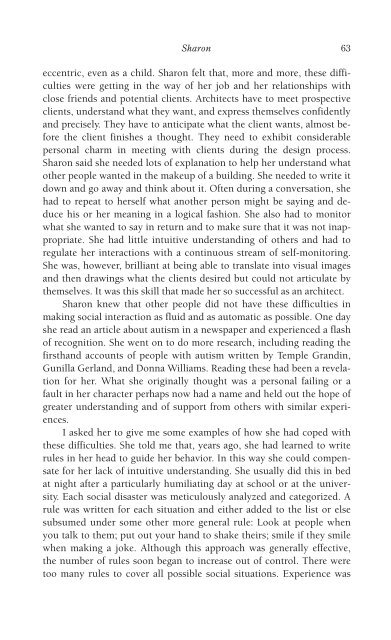978-1572305441
autism
autism
You also want an ePaper? Increase the reach of your titles
YUMPU automatically turns print PDFs into web optimized ePapers that Google loves.
Sharon 63<br />
eccentric, even as a child. Sharon felt that, more and more, these difficulties<br />
were getting in the way of her job and her relationships with<br />
close friends and potential clients. Architects have to meet prospective<br />
clients, understand what they want, and express themselves confidently<br />
and precisely. They have to anticipate what the client wants, almost before<br />
the client finishes a thought. They need to exhibit considerable<br />
personal charm in meeting with clients during the design process.<br />
Sharon said she needed lots of explanation to help her understand what<br />
other people wanted in the makeup of a building. She needed to write it<br />
down and go away and think about it. Often during a conversation, she<br />
had to repeat to herself what another person might be saying and deduce<br />
his or her meaning in a logical fashion. She also had to monitor<br />
what she wanted to say in return and to make sure that it was not inappropriate.<br />
She had little intuitive understanding of others and had to<br />
regulate her interactions with a continuous stream of self-monitoring.<br />
She was, however, brilliant at being able to translate into visual images<br />
and then drawings what the clients desired but could not articulate by<br />
themselves. It was this skill that made her so successful as an architect.<br />
Sharon knew that other people did not have these difficulties in<br />
making social interaction as fluid and as automatic as possible. One day<br />
she read an article about autism in a newspaper and experienced a flash<br />
of recognition. She went on to do more research, including reading the<br />
firsthand accounts of people with autism written by Temple Grandin,<br />
Gunilla Gerland, and Donna Williams. Reading these had been a revelation<br />
for her. What she originally thought was a personal failing or a<br />
fault in her character perhaps now had a name and held out the hope of<br />
greater understanding and of support from others with similar experiences.<br />
I asked her to give me some examples of how she had coped with<br />
these difficulties. She told me that, years ago, she had learned to write<br />
rules in her head to guide her behavior. In this way she could compensate<br />
for her lack of intuitive understanding. She usually did this in bed<br />
at night after a particularly humiliating day at school or at the university.<br />
Each social disaster was meticulously analyzed and categorized. A<br />
rule was written for each situation and either added to the list or else<br />
subsumed under some other more general rule: Look at people when<br />
you talk to them; put out your hand to shake theirs; smile if they smile<br />
when making a joke. Although this approach was generally effective,<br />
the number of rules soon began to increase out of control. There were<br />
too many rules to cover all possible social situations. Experience was



